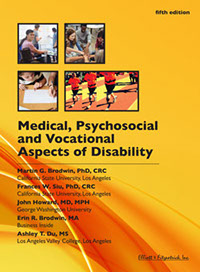 Medical, Psychosocial and Vocational
Medical, Psychosocial and Vocational5th Edition, 2020
M. G. Brodwin, PhD, CRC
F. W. Siu, PhD, CRC
J. Howard, MD, MPH
E. R. Brodwin, MA
A. T. Du, MS
The 5th edition of this medical text, edited by Dr. Marty Brodwin and his associates, is a completely revised version of this popular medical resource which is widely used in Rehabilitation Counselor Training Programs for over 25 years.
The text contains 33 chapters on selected topics in medicine and rehabilitation. The chapters fall within the following major categories: Rehabilitation Medicine, Common Medical Conditions, Sensory Organ Conditions, Brain and Spinal Cord Conditions, Neuromuscular and Joint Conditions, Psychosocial Conditions, Developmental Conditions, Assistive Technology and Reconstructive Repair, and Genetics. The text also contains an Appendix of Medical Terminology and a detailed Index. The text provides a discussion at the end of each chapter, along with a brief case summary to illustrate how the information is relevant to the person/client. The intent of the authors is to present medical and psychosocial information and make the information relevant to the rehabilitation process for person with disabilities. Although the text is used in a variety of settings, the resource was initially developed and revised every five years specifically for the student in the rehabilitation counseling training programs at major universities around the country. The lead author, Dr. Marty Brodwin, was a long time rehabilitation educator (recently retired) at California State University at Los Angeles.
5th Edition:![]() B173
B173![]() $129.95
$129.95![]() |
|![]() ISBN 978-0-945019-07-7
ISBN 978-0-945019-07-7
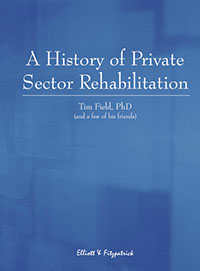 A History of Private Sector Rehabilitation
A History of Private Sector RehabilitationTim Field spent two years attempting to research, recreate and record the private sector rehabilitation movement – from the early years in the late 1970s and the approximately twenty years following. While a few of the early “founders” have already departed, many of the early players submitted information and narratives from what they were able to recall. Discussion is provided of the progression of rehabilitation laws, policies, and regulations, and the general historical context during which the profession of the private sector developed. To add to the larger picture of what evolved during those years, Tim asked people to write about their experiences during the formative years of the profession, as well as their own journey(s) through the 1980s and 1990s. Thirty-two people responded to the call and wrote individual stories based on their own experiences. The people contributing were:
M. Barros-Bailey, J. Carlisle, T. Denneen, T. Field, M. Graham, H. Kulman, C. Peacock, B. Roberts, L. Sinsabaugh, R. Weed, P. Dunn, R. Hall, B. McMahon, K. Preston, J. Berg, G. Broughton, P. Bussey, H. Caston, A. Choppa, C. Johnson, D. Funk, K. Jayne, A. Neulicht, S. Shedlin, S. Stipe, D. Taylor, R. Taylor, J. & J. Truthan, G. & S. Van de Bittner, and G. Watters.
The stories are compelling, interesting, and add both flavor and vital information about the early years. Content of the book includes narratives about the three main associations (NARPPS/IARP, ABVE, & AREA). The appendices include interesting information about past presidents, journal editors, conference sites, awards, and related data. This is a first attempt at a history of our profession and, hopefully, will encourage others to add to the forty years of development and progress. (Field, 2017, 298 pp).
B45 ![]() $29.95
$29.95![]() |
|![]() ISBN 978-0-945019-04-6
ISBN 978-0-945019-04-6
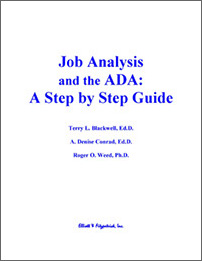 Job Analysis and the ADA: A Step by Step Guide
Job Analysis and the ADA: A Step by Step GuideThis resource contains materials, content and format that address the worker trait variables in the DOT and the critical points of the ADA law. Several detailed worksheets are included within the text along with an easy and straightforward guide to completing the entire job analysis process. (Blackwell, Conrad & Weed, 1992, 160 pp.)
B176 ![]() $25.00
$25.00 ![]() |
|![]() ISBN 0-945019-37-8
ISBN 0-945019-37-8
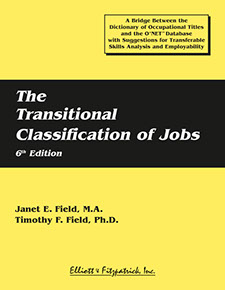 The Transitional Classification of Jobs
The Transitional Classification of JobsThe Transitional Classification of Jobs (6th Edition) contains the primary database of the Dictionary of Occupational Titles with crosswalks to the O*NET database, including the 1998 revision of the Standard Occupational Classification (SOC). In order to reflect the future direction of these occupational databases, the Transitional COJ has dropped some earlier crosswalks, and has placed a great deal more emphasis on the Online O*NET and related links.
The primary objective of theTransitional COJ is to provide a bridge between the 4th Edition of the Dictionary of Occupational Titles and the emerging O*NET database. While transferable skills analyses have historically been completed with the DOT and the worker trait structure, this method suffers from a growing obsolescence and lack of support and development by the US Department of Labor. Rather, DOL has developed and will continue to develop and support the new online,"dynamic" database referred to as the O*NET.
The main body of this resource presents the databases for both the DOT and the O*NET. Crosswalks are provided between the two databases along with bridges to the SOC, the work fields, and various on-line links to new occupational wage and survey data. The introduction also addresses the general issue of transferability and employability. The traditional DOT method for TSAs is outlined in the seven-step format previously included in earlier versions of the COJ. A second method outlines an approach using both the DOT and a greater emphasis on the O*NET data resources. Both methods are illustrated in the appendix of the book. Other appendices include two SSA rulings, general information on the worker traits and occupational codes, a detailed overview of the O*NET, and a rather comprehensive list of references related to transferability, the two databases, and the work of the vocational expert within the context of the transferability/employability issue. (Field, J. & Field, T., 2004, 476 pp.)
B01 ![]() $129.95
$129.95 ![]() |
|![]() ISBN 0-945019-89-0
ISBN 0-945019-89-0
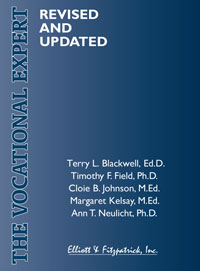 The Vocational Expert: Revised and Updated
The Vocational Expert: Revised and UpdatedThe Rehabilitation Consultants Handbook is completely updated with fresh ideas, illustrations and references. A must resource for the present rehabilitation professional, the Handbook covers important topics such as: case preparation, expert work, transferability, labor market access, life care planning, lost earning capacity, and much more. The appendices are loaded with vital references and data that will serve the professional as a primary source of information in future case development. This resource has been revised and updated over the last 18 years and has become a standard reference for private sector rehabilitation. (Weed & Field, 4th Edition, Revised, 2012, 442 pp.)
B110 ![]() $29.95
$29.95 ![]() |
|![]() ISBN 0-945019-97-1
ISBN 0-945019-97-1
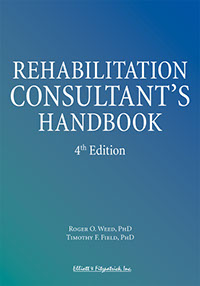 The Rehabilitation Consultant's Handbook
The Rehabilitation Consultant's HandbookThe Rehabilitation Consultants Handbook is completely updated with fresh ideas, illustrations and references. A must resource for the present rehabilitation professional, the Handbook covers important topics such as: case preparation, expert work, transferability, labor market access, life care planning, lost earning capacity, and much more. The appendices are loaded with vital references and data that will serve the professional as a primary source of information in future case development. This resource has been revised and updated over the last 18 years and has become a standard reference for private sector rehabilitation. (Weed & Field, 4th Edition, Revised, 2012, 442 pp.)
B09 ![]() $89.95 (soft cover)
$89.95 (soft cover) ![]() |
|![]() ISBN 978-0-9855538-0-7
ISBN 978-0-9855538-0-7
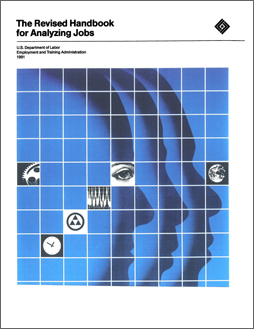 The Revised Handbook for Analyzing Jobs
The Revised Handbook for Analyzing JobsBeginning with an in-depth description of Job Analysis, its uses and principles, the Revised Handbook for Analyzing Jobs is filled with 165 pages of useful information for the rehabilitation professional. This fourth revision also includes chapters on worker function, work fields, MPSMS, GED, SVP, Aptitudes, Temperaments, GOE, Physical Demands and Environmental Conditions. The reader is familiarized with such topics as writing job summaries, task descriptions, and Job Analysis Reports. Other helpful resources include organization and workflow charts along with a step-by-step guide to the Narrative Report. May be used with the ADA Job Analysis Worksheet. Corresponds with the 1991 DOT and the revised list of 72 worker traits. (1991,165 pp.)
B128 ![]() $39.95
$39.95 ![]() |
|![]() ISBN 0-160358-77-9
ISBN 0-160358-77-9
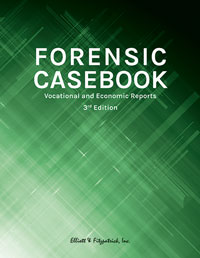 Forensic Casebook: Vocational
Forensic Casebook: Vocational The Forensic Casebook is a resource which reproduces case reports which were actually processed and/or adjudicated in state and federal courts. The book contains twenty-two cases written by nineteen different rehabilitation professionals with considerable experience in the field of forensic rehabilitation and economic. This is a useful resource for other professionals, especially professionals new to the field, who desire to know how reports were written and presented in hearings and/or courts. (Field, J. & Field, T., Eds., 2017, 330).
B42 ![]() $35.95
$35.95 ![]() |
|![]() ISBN 978-0-692-61424-2
ISBN 978-0-692-61424-2